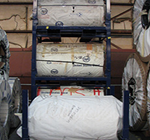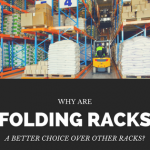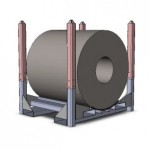Single Bay vs. Multi-Bay Racking: Choosing the Right System for Your Needs
Efficient storage systems are a critical component of warehouses and industrial settings. These systems play a pivotal role in maintaining organized, accessible, and productive operations. In this blog, we will highlight the significance of efficient storage systems in warehouses and industrial settings, provide an overview of single bay and multi-bay racking systems and guide readers in selecting the most suitable system for their specific needs.
In warehouses and industrial facilities, effective storage is paramount. It ensures that products, materials, and inventory are stored in a structured manner, allowing for easy identification, retrieval and inventory management. Efficient storage systems optimize space utilization, minimize the risk of damage or loss, and enhance overall operational efficiency.
There are two primary types of storage systems: single bay and multi-bay racking systems
- Single bay racking systems: Single bay racking systems consist of a single row of racks. They are commonly used in facilities with smaller storage needs or limited space. Single bay racks are relatively simple to install and offer cost-effective storage solutions.
- Multi-bay racking systems: Multi-bay racking systems, on the other hand, involve multiple rows of interconnected racks. They are designed for larger storage volumes and are ideal for warehouses with high inventory turnover or extensive storage requirements.
Overview of Single Bay Racking
Single bay racking is a type of storage system that is characterized by its simplicity and standalone structure. It consists of a single row of racks, typically arranged parallel to the walls or columns of a warehouse or industrial facility. Each rack within the single bay system is designed to store and organize items, providing a straightforward solution for storage needs.
The main feature of single bay racking is its independent nature. Unlike multi-bay systems, single bay racks do not rely on interconnected rows for stability or support. Each row of racks can stand alone, making it easier to install and reconfigure according to changing storage requirements.
Advantages of Single Bay Racking
- Simplicity and ease of installation: Single bay racking systems are known for their simplicity. With only one row of racks to set up, installation is relatively straightforward and can be done with minimal complexity.
- Cost-effectiveness for smaller storage needs: If you have limited storage needs or a smaller inventory volume, single bay racking can be a cost-effective option.
- Flexibility and adaptability to changing requirements: Single bay racking offers flexibility in terms of layout and reconfiguration. The standalone nature of each row allows for easy adjustments to accommodate changing storage needs.
Limitations of Single Bay Racking
- Lower storage capacity compared to multi-bay systems: One of the main limitations of single bay racking is its relatively lower storage capacity. Since it consists of only one row of racks, the overall storage volume that can be accommodated is limited compared to multi-bay systems.
- Limited accessibility and efficiency for large-scale operations: In facilities with extensive operations and high volume storage, single bay racking may present limitations in terms of accessibility and efficiency.
- Potential inefficiency in space utilization: Single bay racking systems may not maximize space utilization as effectively as multi-bay systems. With only one row of racks, there may be unused or underutilized space in the storage area.
Overview of Multi-Bay Racking
Multi-bay racking is a storage system that involves multiple rows of interconnected racks, forming a comprehensive and integrated storage infrastructure. Unlike single bay racking, which consists of standalone rows, multi-bay racking connects the rows together to create a cohesive and efficient storage solution.
The interconnected nature of multi-bay racking provides stability, support, and enhanced structural integrity. This allows for the utilization of vertical space and efficient storage of a larger volume of items within a given area. With multiple rows of racks working together, multi-bay racking systems offer a higher storage capacity and density compared to single bay systems.
Advantages of Multi-Bay Racking
- High storage capacity and density: One of the key advantages of multi-bay racking is its ability to maximize storage capacity and density. By utilizing vertical space and interconnected rows, these systems can accommodate a significantly larger volume of items compared to single bay racking.
- Increased accessibility and efficiency in handling and picking: Multi-bay racking systems are designed to enhance accessibility and efficiency in the storage and retrieval process. With multiple interconnected rows, items can be accessed from different directions, allowing for faster and more streamlined picking.
- Ideal for large-scale operations and high-volume storage needs: Multi-bay racking is well-suited for large-scale operations that require extensive storage capabilities. Whether it’s a distribution center, a manufacturing facility, or a warehouse dealing with substantial inventory turnover.
Limitations of Multi-Bay Racking
- Higher initial investment and installation complexity: Implementing a multi-bay racking system typically involves a higher initial investment compared to single bay racking. The interconnected nature of the system requires additional components, such as beams, connectors, and bracing, which can contribute to increased costs.
- Reduced flexibility for changing layouts or requirements: Once the system is set up, making significant changes to the layout or configuration can be challenging. This can be a consideration for businesses that anticipate frequent changes in their storage requirements or those that prioritize easy reconfiguration.
- Requirement for adequate floor space: Multi-bay racking systems necessitate sufficient floor space to accommodate the interconnected rows and allow for efficient movement and access. Before implementing a multi-bay system, it is crucial to assess the available floor area and ensure it meets the space requirements of the storage system.
Factors to Consider when Choosing between Single Bay and Multi-Bay Racking
- Storage Needs and Volume: Consider the quantity and types of items you need to store. Assess whether you deal with small or large items, and evaluate the potential growth of your storage needs. This will help you determine the storage capacity and weight-bearing capabilities required.
- Accessibility and Handling Efficiency: Analyze how often you retrieve items and the speed of your operations. Consider the ease of access for both personnel and equipment. If you require frequent access to items and efficient handling, a system that allows quick retrieval, such as multi-bay racking, may be more suitable.
- Space Availability and Layout Flexibility: Evaluate the available floor space and ceiling height in your facility. Determine if you have enough space for installation and movement between racks. Consider whether your storage layout is likely to change frequently, as this will affect the system’s flexibility requirements.
- Budget and Cost Considerations: Compare the initial investment, installation, and ongoing maintenance costs of single bay and multi-bay racking systems. Assess the long-term value and potential return on investment for each option. Consider which system aligns with your budget and offers the most cost-effective solution.
Remember to align your storage requirements with the appropriate racking system. If you are unsure about which system is best for your specific needs, don’t hesitate to seek professional advice. SPS Ideal Solutions is one of the top and renowned names on the list. The company ensures industrial safety by providing high-quality warehouse storage racking systems. These systems help reduces common warehouse injuries. For any inquiries or questions, feel free to reach out to us at info@spsidealsolutions.com or give us a call at +1-585-738-5454. We are here to assist you.
Related Posts:
- How to Choose a Suitable Storage Rack System for Your Warehouse?
- How Does Adjustable Pallet Racking System Optimize Warehouse Storage Efficiency?
- Factors to Consider When Determining the Pallet Rack Capacity
- How to Prevent Accidents Due To Warehouse Storage Racking?
About The Author












